After Decades of Debate, is Ontario Ready for Police to Collect data Based on Race?
The air was already fraught with tension inside the North York committee room before the police officer even opened his mouth.
On that February day in 1989, the city outside was a powder keg. Race relations were strained and communities in Toronto and beyond were outraged over recent police killings of unarmed black men, one of whom was only 17.
Against this backdrop, staff inspector Julian Fantino, who would later serve as Toronto police chief from 2000 to 2005, had been hauled before a committee to respond to allegations of discriminatory policing.
Instead of defusing a combustible situation, he put a lit match to it.
In the Jane and Finch area, he said, black people committed 82 per cent of robberies and muggings, 55 per cent of purse snatchings and 51 per cent of drug offences.
Fantino added that “an inordinate amount of serious crimes†involved black people.
Those crimes were a “significant reason for the tensions†between cops and community, he said.
The public outcry was fast and furious. Community activists swiftly denounced his statistics as “disgusting and racist garbage†and criticized police for releasing such stigmatizing figures without transparency or context.
A week after Fantino’s remarks, a new policy was hastily introduced, banning officers from compiling or publishing race statistics. A 2007 policy effectively overturned the ban, allowing police officers to make a request to collect and analyze race or ethnicity data.
According to Toronto police, not a single request has been made, though the force conducted an internal analysis of race in the context of carding, referenced in a secret report later obtained by the Star.
Today, race data is only mandatorily collected and reported by Toronto police in the context of the police practice of carding. The rule to publicly report this only came into effect on Jan. 1.
Nearly three decades after that 1989 meeting, the controversy that engulfed Fantino’s inflammatory comments is still giving off heat.
“Race-based statistics†became politically radioactive. Many attempts to push for race data collection have failed.
“It was a hot potato,†said Barbara Hall, Toronto mayor from 1994 to 1997 and a former Ontario human rights commissioner.
“People didn’t want to go there.â€
For years, anti-racism advocates agreed: no more race-based statistics. In the years since, the tide of public opinion has shifted.
Research into racially biased policing has deepened and the public’s demand, and appreciation, for data of this kind has grown.
In the U.S., race data has proven instrumental in revealing problems of discriminatory policing. Some also point to the Star’s racial profiling investigations as providing the proof of concept that while race-based statistics can be misused to stigmatize vulnerable groups, they can also be a powerful tool to expose and destroy systemic racism.
“It’s not the collection of data; it’s the criminalization of data about us that has been the concern,†said Anthony Morgan, a community advocate and lawyer.
“We’ve come to a place where we see the power and importance of having more data and we are less fearful of the ways in which that data will be manipulated.â€
Calls for police to start collecting and releasing race-based data that capture police interactions with the public have grown louder.
With the rewriting of Ontario’s Police Services Act and the review of the province’s police oversight bodies, both of which are expected to be unveiled in the coming weeks, a rare window of opportunity has opened for the province to mandate that police collect data based on race.
But 28 years after a disastrous community meeting slammed the door on the practice, is Toronto, and the rest of Ontario, ready for this?
For all the angst surrounding race data, collecting the information requires just a small act: checking a box, or pushing a button on a touchscreen.
The cumulative potential of these small acts can be huge.
For proof, look no further than Oakland, Calif., home to one of the most controversial law enforcement agencies in the U.S.
A fact about Oakland: if you are a man in this city of roughly 400,000, police are far more likely to stop you if your skin is black.
Another fact: if you are a black man stopped by Oakland police, you are more likely to be searched, arrested and even spoken to harshly. You have a 1-in-4 chance of being handcuffed, even if you’re not arrested.
Oakland’s black residents know all this because they live it. Now the rest of the world knows it, too, thanks to statistics published by Stanford University researchers hired by the City of Oakland.
These findings were revealed by the data, reams of it, pulled from 28,119 forms compiled over the course of a year, recording the race of every Oaklander stopped by police on the street or in a car. The Stanford study produced 50 recommendations to help Oakland police fix a culture “whereby it’s more acceptable to stop, search, handcuff, and arrest African Americans than whites.â€
Just 33 have been implemented or initiated. More work lies ahead.
But these important steps would not have been possible if police weren’t collecting data based on race.
“The time when police departments would simply say, ‘We’re not going to gather any data’ is probably in the past,†said David A. Harris, a law professor with the University of Pittsburgh and an expert on racial profiling.
“When there’s no data, nobody can prove anything one way or the other.â€
But like many U.S. police services that now collect race-based data, Oakland police had to be forced to do it.
They were ordered to do so following a high-profile legal settlement with 119 plaintiffs, most of whom were black. The plaintiffs accused four rogue cops of beatings, kidnappings and falsifying evidence. The plaintiffs were ultimately paid nearly $11 million (U.S.) in damages in 2003, the largest settlement in Oakland’s history.
Every other police service in California is now required to collect and publicly report the data through a bill passed by the legislature in 2015.
In Ontario, many advocates pushing for data to be collected believe that police services here, too, will have to be forced to do it.
It was this kind of data that showed Ottawa police last year that officers were more likely to pull over Middle Eastern and black male drivers in a traffic stop than those who were white, particularly if the drivers were young.
The two-year data collection project was the result of a settlement between the Ottawa Police Services Board and the Ontario Human Rights Commission following a complaint by Chad Aiken, a young black man alleging racial profiling.
The Ottawa police response to the data is part of the reason Renu Mandhane, Ontario’s chief human rights commissioner, believes the province is in a “hopeful moment.â€
Ten years ago, Mandhane said, the police response would have been more defensive, far more likely to have included claims that the data showed racialized people commit more traffic crime, and outright denials about the possible role of racial profiling.
But this was not how Ottawa police responded.
“In my conversations with police leadership, many of them have moved beyond questioning whether racial discrimination, or racism, exists,†Mandhane said.
Mandhane and the commission, which has been pushing for the collection of race-based police data for more than a decade, are under no illusions that police will collect the data voluntarily.
As part of the overhaul of the Police Services Act, which has not been revised for 25 years, the commission is urging the province to require police to collect data on identity, including information on race, in all stops of civilians and incidents involving the use of force.
The commission made the same recommendation to Ontario Court of Appeal Justice Michael Tulloch. For the past year, Tulloch and his team have been reviewing police watchdogs, including the Special Investigations Unit, which does not collect race data in its probes of fatalities, serious injuries and allegations of sexual assault involving police.
Tulloch’s report is due at the end of the month, while the changes to police legislation are expected to be unveiled this spring.
To many, the success of both turns on the question of race-based data.
“I would argue that the revision of the Police Services Act and the Tulloch Review will not have fulfilled their mandate if neither include provisions for the collection, analysis and dissemination of race-based statistics,†said Akwasi Owusu-Bempah, an assistant professor of criminology at the University of Toronto and an expert in race and policing.
Morgan, the lawyer and community activist, adds that race-based data is a vital part of evidence-based policy making in policing and beyond, including measuring the need for reforms to everything from schools and housing to health and prisons.
“It gives us greater access to the levers of both change and accountability.â€
If recent developments are any indication, Queen’s Park appears to be warming to the idea of race-based data.
Last year, in its new regulations governing carding, the province mandated that police services release annual statistics on things such as the race, sex and age of those stopped. The children and youth minister also vowed that Ontario’s 47 children’s aid societies would start collecting race data, as part of efforts to reduce the high number of black kids in care.
Earlier this month, the province’s anti-racism directorate announced proposed legislation that, if passed, will require the collection of data on race and ethnicity within several government sectors, including the justice system.
Asked whether the revised Police Services Act will include direction for police to begin collecting data on race, Yasir Naqvi, Ontario’s attorney general, said the new law is under development.
“So much of our work is focused on community-based prevention, evidence-based prevention. In order for that to take place appropriately, to develop community-based evolving plans, you need that data,†Naqvi said.
As for Toronto police, spokesperson Meaghan Gray didn’t say whether the service or the police chief would support race-based data collection, but pointed to Ontario’s new carding regulations, which require the gathering and reporting of this data.
The province will likely face strong opposition from chiefs and police associations, says former Kingston police chief Bill Closs, who is now retired.
In 2003, Closs made the unprecedented move to begin collecting race-based data from stops by his officers. The two-year project showed that black people were stopped three times as often as white people. The revelation prompted a tearful apology from Closs.
The backlash from inside the policing community was swift: the Kingston Police Association attacked the study. When then premier Dalton McGuinty was asked if he would instruct police services to collect the same data, he said he wouldn’t tell police what to do.
In his 43 years of policing, Closs said the race data project was “the most depressing and rewarding time of my life.â€
“Everybody outside of the government and policing community were congratulating us or were supporting us. But (there was) intense negativity from police chiefs, from police unions and — what was bitterly disappointing — from the government,†Closs said in an interview.
Closs admits his experience left him cynical about the prospects of provincial lawmakers forcing police to collect data involving race, but he said he would like to be “pleasantly surprised.â€
He stresses that, if police are required to collect the data, it should include officers providing the rationale for their decisions; officers in the Kingston study didn’t just mark down the perceived race of the person stopped, but included the reason they pulled over a car or spoke to someone walking down the street. That information provides an all-important glimpse into an officer’s mind, the subconscious bias that may exist within good police officers.
In Closs’s experience, race-based data can expose problems, inform officer training and build bridges within the community.
“It’s going to take somebody with the courage, in government, to say, ‘It’s time to do this.’â€
Race-based statistics’ long and tortured history in Toronto
Feb. 16, 1989: Controversy erupts after police officer Julian Fantino, then a 31 Division staff inspector, uses statistics to bolster his claim that “an inordinate amount of serious crimes†in the Jane-Finch area involve black people. Fantino said he manually counted crime occurrences in the area, basing his figures on arrests and ongoing investigations, and in some cases categorized the perpetrator’s race based on the victim’s report. He later apologized to the black community.
Feb. 18, 1989: Solicitor-General Joan Smith calls on police to immediately stop collecting crime statistics based on racial background, saying the practice “accomplishes nothing useful†and “only fuels prejudice where prejudice exists.â€
Feb. 23, 1989: The Metropolitan Board of Commissioners of Police adopts a motion stating that officers should not “compile or publish statistics relative to race, colour or creed of individuals involved in criminal activity, except as approved by the board.†The policy does not affect releases that describe wanted suspects.
July 24, 1991: Sgt. Benjamin Eng ignites controversy after telling an inquiry that refugees from Vietnam and mainland Chinese commit the “vast majority†of crime in Toronto’s Asian community, citing statistics that he personally compiled.
Sept. 10, 1992: Metro auditor Allan Andrews releases a review of race-relations practices that found “evidence of bias in interviews with officers’ in all ranks.†He makes 74 recommendations, including that the force reconsider its policy against compiling race-based statistics.
April 21, 1994: After the infamous “Just Desserts shooting†— involving a young white woman killed during an armed robbery — Metro police union president Art Lymer is quoted in newspapers advocating for the collection of race-based statistics if it will help “get to the root†of local crime problems.
March 24, 2000: Criminology professors Scot Wortley and Gail Kellough release a report that draws from race data to show that black people are routinely treated more harshly than white people in the criminal justice system. Wortley called on police to acknowledge the problem. “There's a reluctance to talk about it or a flat denial that 'we treat everybody the same.'“
Oct. 19, 2002: Using police crime data obtained through freedom of information requests, the Toronto Star publishes an investigative series reporting that black people arrested by police are treated more harshly than white people. The Toronto Police Association denounces the series, filing a $2.7 billion class action libel suit that is ultimately dismissed by the courts.
Oct. 3, 2003: A joint working group on race relations releases a 110-page draft report, recommending that while the police ban on compiling race-based statistics should stand, the Ontario government should also review whether race and ethnicity data should be added to police statistics.
May 26, 2005: Kingston’s Police Chief Bill Closs tearfully apologizes after the publication of a damning report, revealing that black people in his city were stopped three times more often than white people between October 2003 and September 2004. The report is attacked by the police union, which says these studies “don’t prove or disprove anything.â€
Oct. 18, 2007: The Police Services Board approves a new policy that supersedes the 1989 ban, now allowing police to “collect, use and report statistics†on race and other grounds. But the procedure for doing so requires that officers first submit a request and obtain approval, including from the police chief. No requests have been submitted to date.
Feb. 6, 2010: Toronto Star reporter Jim Rankin publishes an investigation into police carding practices (once again using data obtained through freedom of information requests), finding that black people in Toronto are three times more likely to be stopped by police than white people. The story ignites fresh controversy and debate, including over whether police should start routinely collecting and analyzing race data.
April 29, 2016: The Ontario Human Rights Commission submits recommendations to the province, which is reviewing the Police Services Act for the first time in 25 years. One of their recommendations — backed by at least 22 community and advocacy groups — is to require that police collect and report “human rights-based data on all stops of civilians,†including on race and ethnicity.
Oct. 24, 2016: York University researchers release a study showing that Middle Eastern and black drivers were far more likely to be stopped by Ottawa police than other drivers between 2013 and 2015. The study was conducted as part of a human rights complaint settlement.
March 7, 2017:
The province’s anti-racism directorate announces a new strategy for
tackling systemic racism. The strategy includes new legislation which,
if passed, will mandate the collection of race-based data in various
government sectors, including justice.
Comments
There are 0 comments on this post





